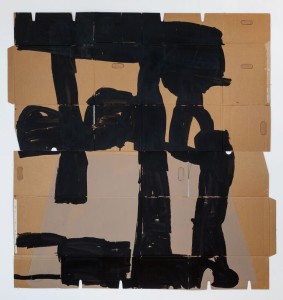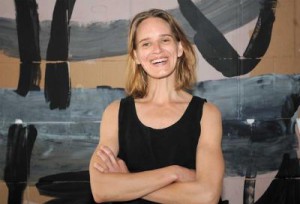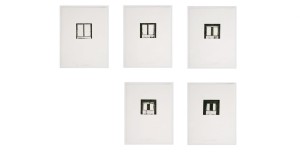October 19 – November 30, 2016
On view at Anita Rogers Gallery
A man can look at this little pile on his bureau for thirty years and never once see it. It is as invisible as his own hand. Once I saw it, however, the search became possible.
– Walker Percy, The Moviegoer
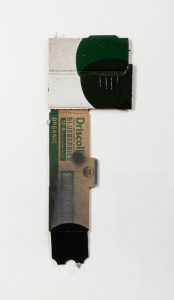 When I was a child I imprinted on Cezanne’s Bather at MOMA, just like those incubator-hatched goslings fixated on the wading boots of the Austrian ornithologist Konrad Lorenz in 1935. It was love at first sight as Lorenz brilliantly directed his babies into the lake for their very first swimming lesson. For me too, the image of that Cezanne was instantly and permanently engraved on my brain: a slender body with hands firmly grasped on his hips and two clumsy feet poised to move forward. Additionally, I detected an echo of my own face and head: skewed downward and resolutely self-righteous and I loved the young man’s expression of cagey dissent. That painting created a void in me the size of the universe. How to fill it?
When I was a child I imprinted on Cezanne’s Bather at MOMA, just like those incubator-hatched goslings fixated on the wading boots of the Austrian ornithologist Konrad Lorenz in 1935. It was love at first sight as Lorenz brilliantly directed his babies into the lake for their very first swimming lesson. For me too, the image of that Cezanne was instantly and permanently engraved on my brain: a slender body with hands firmly grasped on his hips and two clumsy feet poised to move forward. Additionally, I detected an echo of my own face and head: skewed downward and resolutely self-righteous and I loved the young man’s expression of cagey dissent. That painting created a void in me the size of the universe. How to fill it?
Not much happens very fast for me and I’ve come to understand Ad Reinhardt’s guidance: study ten thousand paintings and walk ten thousand miles and make no allowances for haste or, for that matter, anything else because along the way the search does get harder and the road becomes strewn with potholes, dents, regrets and ruts. I’ll take the long view because let’s face it subsidized freedom is for bankers.
Simply put, I admire the stoic and splendidly solemn. I use premixed hardware store paint and a cut-and-build method: stacking and superimposing discarded cardboard just like laying bricks right on top of each other. These blunt marks, poured, cut, slow and shaped, look to me like emblems or bodies longing for life of their own. They need from me no more than to be fixed, pinned down and secured in space, even if occasionally by chance or luck. Vertical, standing, and poised they want to suggest a presence or body or the impression of a handshake or gesture, like the greeting of an old friend. Some of these recently completed works (some started in 2007) have been repainted, reassembled and hammered out over long periods of time. My hope is their insistent physicality makes a reasonable claim for taking up space and that their relentless self-editing gives them bodily restitution, compensating for their acute (absurd) stubbornness. Their meaning is fixed by their own autonomy: they are artifacts, set apart, self-sufficient, and speaking on their own terms. In my better moments I consider them to be visible traces of my hand, rooted in the real, the not-manipulated, and the not-over-parented. So my parting words to them as I deliver them into the world: be like geese, stay calm on the surface and paddle like hell below.
George Negroponte summer, 2016
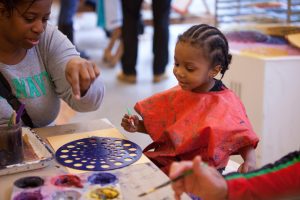
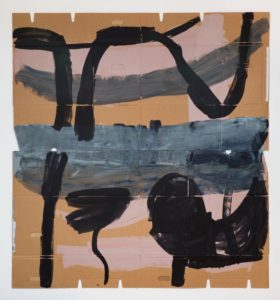 At times, abstract painting can seem like a received package, with little space left to think outside of the box. In Virva Hinnemo, to overplay the postal metaphor, we have an artist “pushing the envelope”—in her case, literally so. A form vocabulary and a gestural lexicon familiar from mid-century American masters Franz Kline, Robert Motherwell and Philip Guston meet the swift completion of their appointed rounds on flattened cartons as their repurposed, eccentric support. This strategy could have smacked of Arte Povera, Supports/Surfaces or currently fashionable “provisional” abstraction, but somehow in the hands of this Springs, NY-based Finnish artist the work manages to come across as visually sophisticated but stylistically innocent. Their charming, unforced modernism fits right into the refreshingly old-fashioned surroundings of this plush new venue, sharing quarters with another of proprietor Anita Rogers’ enterprises and thus itself an eccentric support.
At times, abstract painting can seem like a received package, with little space left to think outside of the box. In Virva Hinnemo, to overplay the postal metaphor, we have an artist “pushing the envelope”—in her case, literally so. A form vocabulary and a gestural lexicon familiar from mid-century American masters Franz Kline, Robert Motherwell and Philip Guston meet the swift completion of their appointed rounds on flattened cartons as their repurposed, eccentric support. This strategy could have smacked of Arte Povera, Supports/Surfaces or currently fashionable “provisional” abstraction, but somehow in the hands of this Springs, NY-based Finnish artist the work manages to come across as visually sophisticated but stylistically innocent. Their charming, unforced modernism fits right into the refreshingly old-fashioned surroundings of this plush new venue, sharing quarters with another of proprietor Anita Rogers’ enterprises and thus itself an eccentric support.